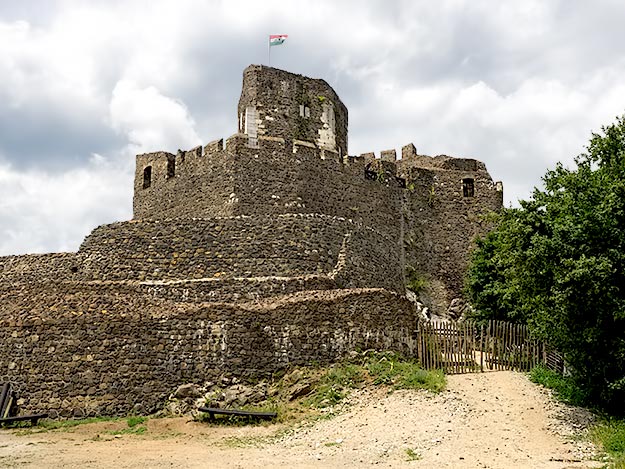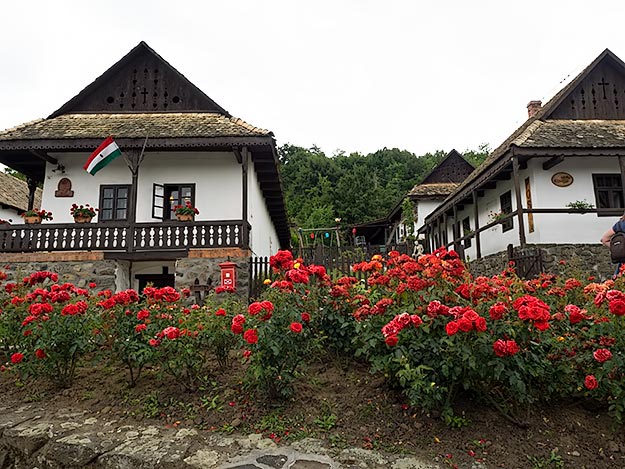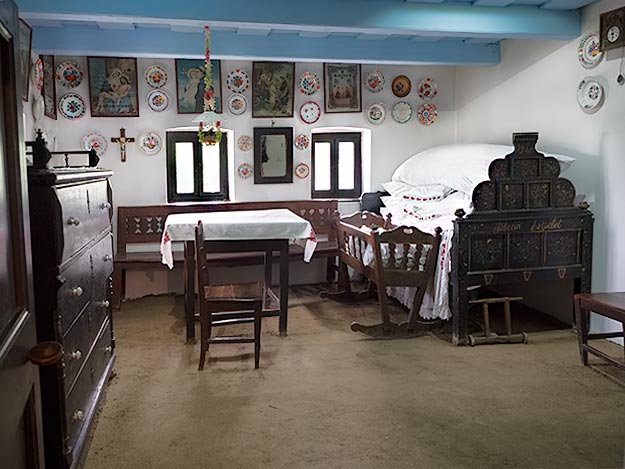Perhaps it was the fairy tale I’d heard earlier in the day that put me in mind of ogres. Approaching Holloko Castle I felt like Jack, the steep path to the top of the hill serving as my beanstalk. The crenelated walls seemed more prison than castle and inside, as I descended into the bowels of the castle, I conjured a giant lying in wait around every turn, sharp teeth poised to make a meal of me.

My vivid imagination aside, it is said that while the castle was still being constructed a member of the Kacsics noble family kidnapped a beautiful maiden from a neighboring village and imprisoned her within one of its cold stone cells. Unfortunately for the nobleman, the girl’s nanny was a witch, and she made a pact with the devil to free her mistress. The devil commanded his sons to assume the form of ravens each night and steal stones from the castle until the girl was set free. Today the town of Holloko echoes this fairy tale; its Hungarian name translates to “raven stone” and the road leading to the village is marked with a bronze statue of a raven perched on a rock outcropping.

The history of the castle hearkens back to the 13th century. Following an invasion by Ottoman Turks in 1241, the Kacsics dynasty began constructing the castle to provide protection for their landholdings and the small village that once existed near its walls. Over the centuries, the castle changed hands numerous times. Ottomans captured it in 1552, and for the next 150 years control alternated between Turks and Hungarians. By 1683, the castle had been abandoned, but that didn’t stop King Leopold I from ordering it destroyed in 1711 after Hungarian nobles attempted to topple the Habsburg dynasty that controlled Hungary.

With the castle in ruins, the village was relocated to the valley below by local Palócz who inhabited the area. Ethnographers believe that the Palócz ethnic group was originally part of the Cuman tribe that once spread across southern Asia. Pushed out by Mongol invaders, they resettled in parts of central Europe, including what is today northern Hungary. Though considered to be ethnically Hungarian, Palócz speak with a distinct dialect and accent and their cultural traditions are unique. Upon settling in Holloko, the Palócz built their traditional wooden homes with no foundations or chimneys and roofed them with thatch. With just a hole in the roof to allow smoke to escape, the homes often burned down.
After a fire decimated the village in 1909, they began building adobe houses with stone foundations and covering their wooden roofs with shingle tiles, while maintaining the original shapes to preserve their ancient folk architecture traditions. Fifty-five of these houses in the old village, along with the 1889 wooden-steepled Catholic church that stands at its center, became the first village in the world to earn UNESCO World Heritage status.

Where the castle had put me in mind of ogres, Holloko was a true fairy tale village. The whitewashed walls of its pristine cottages sparkled in the sunshine. Wooden railings around porches were garnished with geranium-laden flower boxes and gables were decorated with tulip, cross, and heart cutouts that allow rising smoke to escape. A traditional Palócz home has three rooms. The atrium, or kitchen, is where most of the family’s daily activities took place, while the pantry was used to store cereals and also served as a sleeping area for elderly family members.
The clean room was reserved for special occasions, most notably entertaining the family of a potential bridegroom when female children reached marrying age. Potential suitors carefully noted the number of pillows stacked on the bed in the clean room, as they indicated the amount of land that a family owned. Palócz were not above deceit, however, in their efforts to marry off girls to wealthy young men. If a family lacked the requisite number of pillows, they borrowed some from a willing neighbor.

Clothing also indicated status. Women of lesser means wore dresses with old-fashioned bodices made of homespun cloth, narrow aprons, and shawls, topped by strings of beads. Wealthier women wore knee-high boots; dresses with bodices made of purchased cloth; multiple layers of stiffened, embroidered petticoats; much finer shawls; and ornate headdresses decorated with ribbons, beads, flowers, and embroidery. Men wore white shirts and felt trousers, topped by narrow aprons and waistcoats with tulip-shaped buttons. Fabric was expensive, thus wide trouser legs indicated the wearer was wealthy. Most money went to acquiring land, but because matches between prosperous families served to increase the standing of both families, any excess income was spent on fine clothing.
Still today, the Palócz residents of Holloko wear this attire during festivals and for special occasions. At Easter, they don their colorful folk clothes for two days and revive ancient Easter traditions. Since water is seen as a symbol of life and fertility, boys sneak around town with buckets of water, trying to douse the young women they fancy. During Whitsuntide, children’s groups perform traditional Palócz folk dances, and during the month of August, stage plays are performed in the Medieval castle. Most spectacular may be the Vintage festival each fall, when residents dress up in their finest garments and join a procession through the village, signifying that the grape harvest is over and the following year’s wine is assured.

Taking a stroll through Holloko is like riding a time machine back to the past, and the local government is making every effort to ensure that the town’s cultural heritage is preserved. A $7 million Euro grant from the European Union allowed them to purchase several dilapidated homes in the old village and restore them to their original condition. Some are now guests houses, while others are rented to young people at very affordable rates, ensuring that they will be able to stay in town and raise their families. One such home is slated to become a shop that will sell artisan cheeses made by a local family. Another has been turned into a Doll Museum, where rows of dolls in glass cases demonstrate the different traditional Palócz costumes. Yet another shop features pottery made in traditional Holloko designs, where visitors are encouraged to try their hand at throwing pottery.
At the end of the day, I revised my opinion. Holloko is no fairy tale village. The pageantry here is not for show; what they do comes from the heart, rather than out of obligation. In fact, once each month residents put on their finest traditional attire and gather for a community dinner that is not even open to the public. That wouldn’t happen in a place designed just for tourists. Holloko is one of those rare authentic places that all true travelers crave.
Author’s note: Located just 100 kilometers (60 miles) northeast of Budapest, the UNESCO World Heritage village of Holloko, Hungary can be reached in an hour by car from the capital. Buses also leave from Puskás Ferenc Stadion in Budapest at 8:30 every morning, arriving at Holloko about two hours later. (See Vola’n Bus Lines) In addition to accommodations, the village has several restaurants, a visitors center with a well-done historical audio presentation, and is in the process of building a stage for special events and a conference center. To contact the village about staying in one of their guest houses, email [email protected], or call (+36) 32 579 010.

This is amazing a lot of history but it is beautiful
Hi Izy: I am constantly amazed by how much Hungary has to offer, and by how few people seem to go there, especially to the countryside.